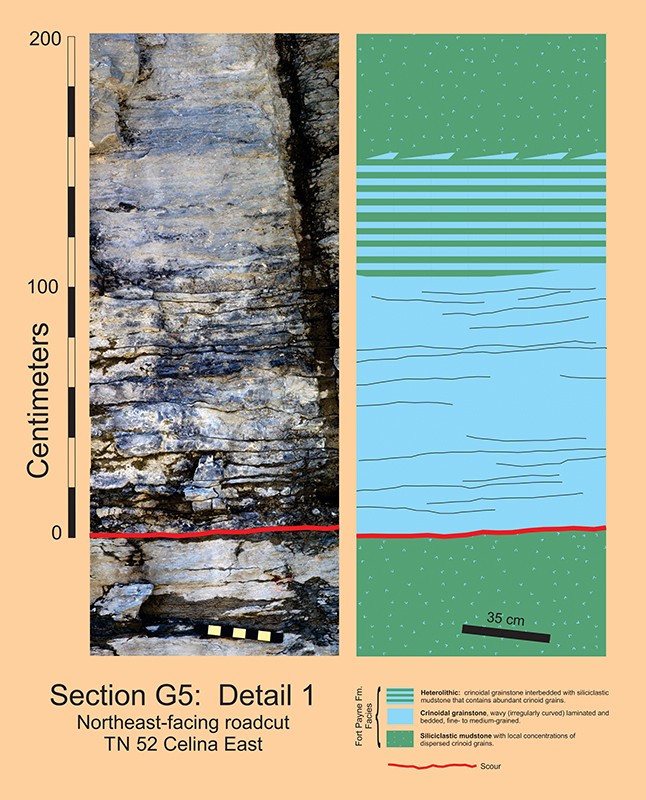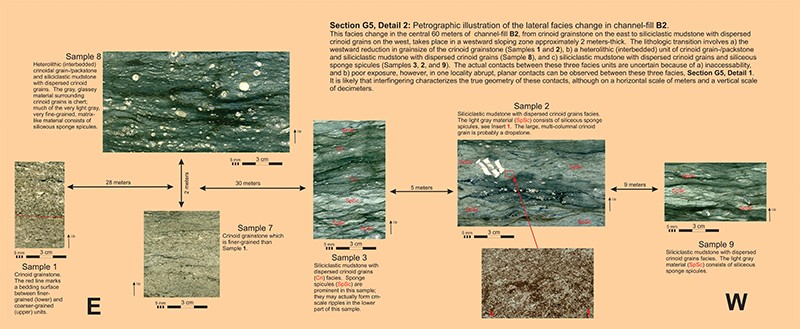Roadcut Sections G1 - G7
These seven roadcut sections in the vicinity of the Poorhouse Road overpass comprise the uppermost Fort Payne strata exposed along TN52 and consist primarily of horizontal, planar bedded siliciclastic mudstone with few planar and horizontal beds of crinoid packstone, units C and D. Unit C serves as a datum not only for all of the G-Sections but also the H- and C- Sections. Channel-fills A and B are the two major channel-fills that occur in the G-Sections, A on the southeastern end and B on the northwestern end, see Figure 2 for locations. Channel-fill A is perhaps the thickest and hence the deepest of all channel-fills exposed along TN52 covered by Figure 2. It has a minimum depth of 17-meters but only a preserved width of 100-meters, which is much shorter than those of the major crinoid grainstone channel-fills in Section C1 (225-meters) and in Sections A1 (200-meters). Channel-fill B is contains crinoid grainstone at its eastern margin, however, the majority of the fill is siliciclastic mudstone; it has a minimum aspect ratio of 170:1.
Section G7
Roadcut Section G7 has the best overall exposure of Channel-fill A which consists of crinoid grainstones (units 1, 2, and 3) with interbedded siliciclastic mudstone with dispersed crinoid grains. The internal stratification of these three grainstones is planar and inclined parallel to each respective basal erosion surface; the immediately overlying siliciclastic mudstone interbeds also have the same stratification pattern. This base-parallel bedding is indicative of uniform deposition across the entire inclined basal erosion surface, resulting in upward oblique accretion. This implies that for the grainstones the depositing currents flowed along the strike of the inclined surface, analogous to the deposition of the epsilon cross bedding in fluvial point bars; the depositional process for the siliciclastic mudstone probably was from suspension settling during the waning portion of a sediment gravity flow. Immediately above grainstone unit 3 on the extreme northwest end of Section G7 there is a facies transition into the overlying siliciclastic mudstone; this transition is significantly better exposed in Section G3-Detail 1. The base of Channel-fill A is exposed in a man-modified slope immediately to the southwest of the roadcut; inclined mudstone occurs in sharp contact with horizontal, planar beds of siliciclastic mudstone a distance of 17-meters below disconformity E which forms the upper contact of Channel-fill A.
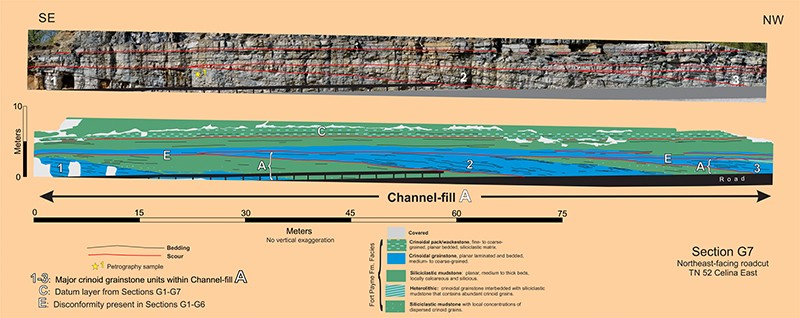
Section G3
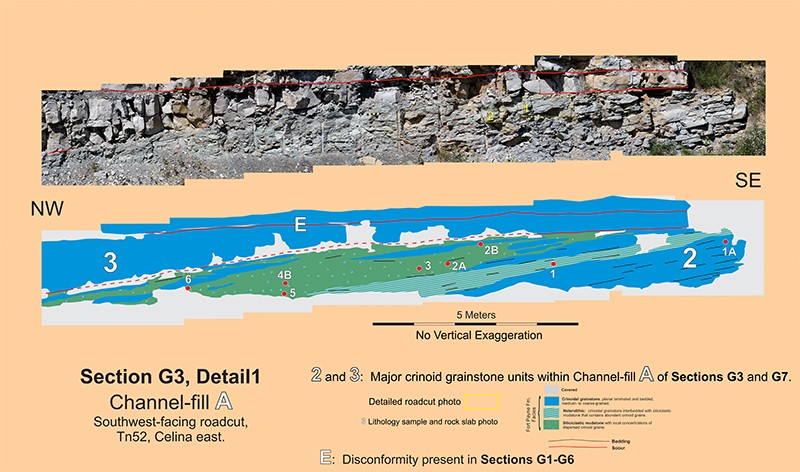
Roadcut Section G3 exposes a monotonous sequence of horizontal, planar beds of siliciclastic mudstone interrupted by two prominent crinoid packstones, units C and D. Unit D has channel-margin termination in the northwestern part of this section which enables the determination of a minimum aspect ratio of 210:1 to be calculated for unit D over its extent from Section G3 northwest through Section G1. The uppermost northwestern part of Channel-fill A of Section G7 is exposed in the lower southeastern corner of Section G3. This road level, readily accessible part of the roadcut graphically exposes a dramatic lateral facies transition from the crinoid grainstones of unit 2 into the adjacent siliciclastic mudstones with dispersed crinoid grains that takes place over a horizontal distance of no more than 4-meters by means of the interfingering of a) crinoid grainstone, b) a centimeter-scale heterolithic (interbedded) unit of crinoid grainstone and siliciclastic mudstone with dispersed crinoid grains, and c) siliciclastic mudstone with dispersed crinoid grains, see Sections G3-Detail 1 (sample locations), G3-Detail 1: road cut photos, G3-detail 1: Polished Slabs, and G3-Detail 2 (polished slab and thin section petrography). Disconformity E passes below road level in the southeastern part of this section.

Section G1

Section G3
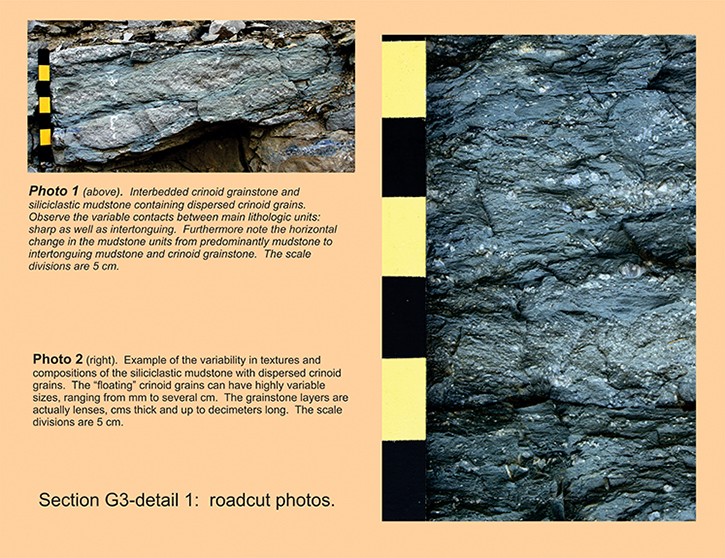
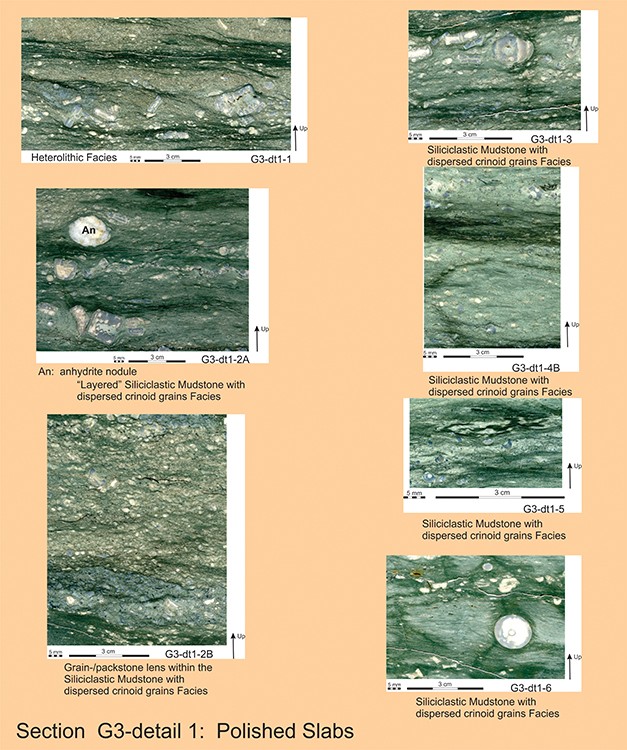
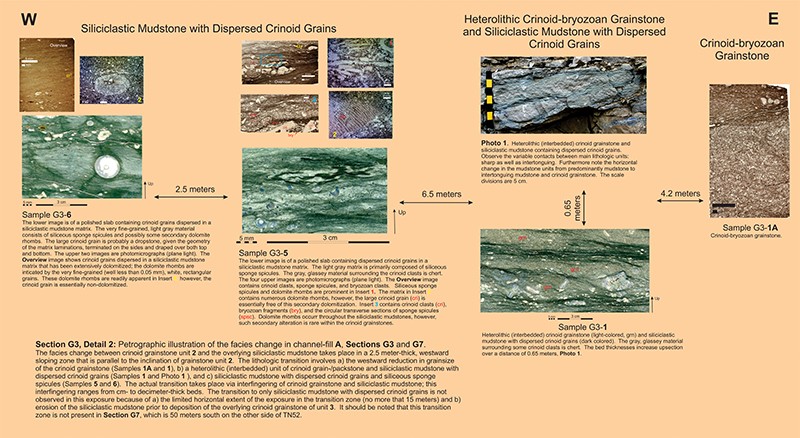
Section G2
Roadcut Section G2 is dominated by a sequence of planar, horizontal beds of siliciclastic mudstone interrupted by the crinoid packstones of units C and D. The pinch-out margin of high aspect ratio Channel-fill B occurs at road level at the northwestern part of this section; its basal erosion surface gradually rising to meet the overlying, and truncating, disconformity E. This southeastern margin of Channel-fill B consists of crinoid grainstone. Disconformity E passes below road level further to the southeast.
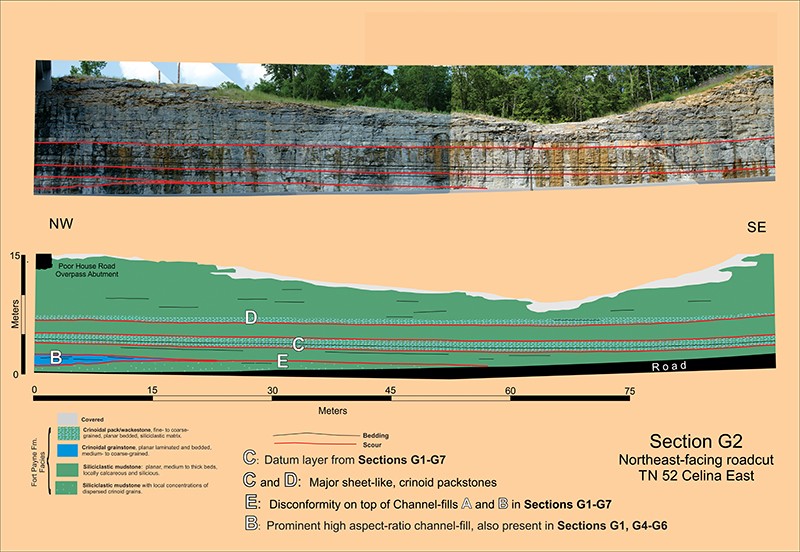
Roadcut Section G1 exposes a monotonous sequence of horizontal, planar beds of siliciclastic mudstone interrupted by two prominent crinoid packstones, units C and D and, at the top, a prominent crinoid grainstone. Channel-fill B is well exposed at the base of this section: a) the southeastern “pinch-out” margin, b) the southeastern crinoid grainstone fill, and c) the northwestern siliciclastic mudstone with dispersed crinoid grains. The dramatic lateral facies change from crinoid grainstone into siliciclastic mudstone occurs over some 40-meters; unfortunately it is poorly exposed because of surface coatings of various weathering products. The complete channel-fill to the southeast is crinoid grainstone and to the northwest siliciclastic mudstone with dispersed crinoid grains. The internal stratification of both facies is planar, horizontal, and parallel to the basal erosion surface; there is onlap indicated immediately adjacent to the gently inclined southeastern “pinch-out” margin. This internal stratification and juxtaposition of two fundamentally different facies is indicative of simultaneous, vertical accretion from a sediment gravity flow that had a pronounced, lateral, energy gradient--higher in the southeast to lower in the northwest. The details of this dramatic facies change are much better exposed on the opposite roadcuts, Sections G4 and G5. Disconformity E truncates both Channel-fills B and B2.
Section G4
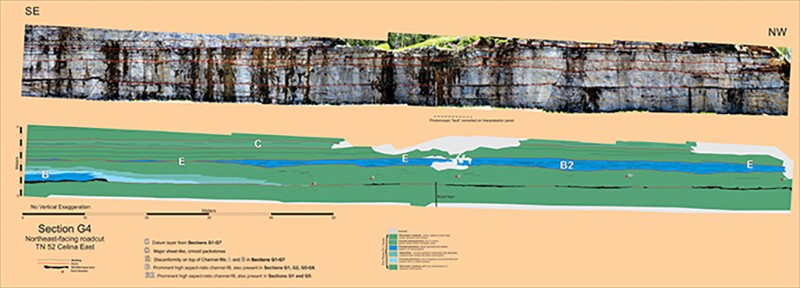
Section G5

Sections G4 and G6 show Channel-fill B on the northeast-facing TN52 roadcuts immediately northwest of the Poorhouse Road overpass. Furthermore, the facies change in this channel-fill between crinoid grainstone to the southeast and siliciclastic mudstone with dispersed crinoids to the northwest is especially well exposed, although it is approximately 3-4-meters above road level, well out of easy examination range. Section G5 is composed of higher resolution, enlarged images of the facies transition zone and thus presents a significantly more detailed view of this critical stratigraphic interval. Moving from the southeastern, gently inclined margin the following facies transition occurs: a) medium- to coarse-grained, crinoid grainstone with planar, horizontal bedding (blue unit), b) fine- to medium-grained, crinoid grainstone with wavy to curved stratification (light blue unit), c) a heterolithic unit with centimeter-scale, planar, horizontal interbeds of crinoid grainstone and siliciclastic mudstone with dispersed crinoid grains (green and light blue unit), and d) siliciclastic mudstone with dispersed crinoid grains (green unit with light blue v’s). This facies transition takes place both laterally and vertically over a horizontal distance of about 50-meters. Because of the inaccessibility of the transition zone itself, the actual geometries of the contacts between adjacent lithologies are poorly known. The only actual facies contacts that could be observed are abrupt and exist between vertically stacked, fine- to medium-grained, crinoid grainstone, heterolithic grainstone/mudstone, and siliciclastic mudstone with dispersed crinoid grains, Section G5-Detail 1. Images of polished slabs illustrating these various lithologies are presented in Section G5-Detail2. Channel-fill B2 cuts down into B and in turn is truncated by disconformity E in the northwestern part of Section G5.
Section G6

Section G5
